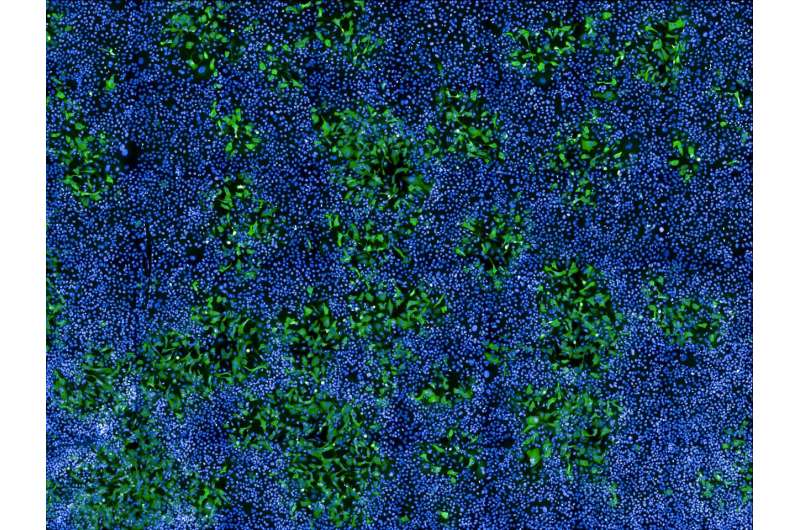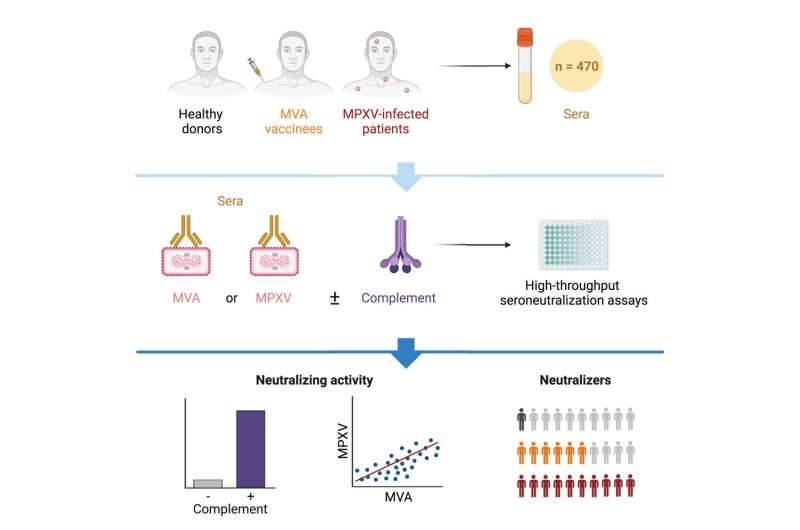This article has been reviewed according to Science X's editorial process and policies. Editors have highlighted the following attributes while ensuring the content's credibility:
fact-checked
peer-reviewed publication
trusted source
proofread
Mpox: Characterization of post-infectious immune response

In 2022–2023, an outbreak of monkeypox, now known as mpox (caused by the monkeypox virus or MPXV) led to 87,000 human cases in 170 countries.
Most cases were reported outside the usual areas in which the virus circulates. Since the outbreak began, surveillance of the virus has been stepped up in Europe, with nearly 5,000 cases being reported in France. Scientists and clinicians from the Institut Pasteur, the CNRS, Inserm, the VRI and the Paris Public Hospital Network (AP-HP) studied 470 sera from vaccinated or MPXV-infected individuals to elucidate the mechanisms involved and determine correlates of protection against infection or disease severity.
They determined the sensitivity of the virus to neutralizing antibodies and analyzed the immune response of these vaccinated or MPXV-infected individuals. The study revealed the role of complement, a component of the innate immune system, in this response. The findings were published in the journal Cell Host & Microbe.
In 2022–2023, an unprecedented epidemic of 87,000 cases of mpox occurred in non-endemic areas, affecting people with no direct link to travel in Central or West Africa, where the virus has historically been present. MPXV is mainly transmitted to humans by rodents, with human-to-human transmission occurring via respiratory droplets or close contact.
Symptoms are less severe than those of smallpox, and the case-fatality rate is lower. According to Santé publique France, approximately 5,000 cases of MPXV infection have been reported in France since May 2022. MPXV is still circulating at very low levels in non-endemic areas, which is why it is important to improve characterization and analyze the immune response of people infected with the virus or vaccinated with IMVANEX, the third-generation vaccine currently available, initially developed for smallpox.
The research teams worked in collaboration with clinicians, vaccinologists and virologists from three French hospitals (Henri Mondor Hospital in Créteil, La Pitié-Salpêtrière Hospital and Orléans Hospital) to carry out this multidisciplinary research. The large number of sera analyzed provided good statistical power, meaning that the analysis could be narrowed to subgroups of patients based on various criteria such as age.

In this study, published in Cell Host & Microbe, the scientists studied the sensitivity of MPXV to neutralizing antibodies (NAbs) generated after infection with the virus and/or vaccination with IMVANEX.
The IMVANEX vaccine has been used as pre- and post-exposure prophylaxis in high-risk populations, but its effectiveness is not yet well characterized. To analyze the sensitivity of the virus, the team of scientists developed two cellular tests to quantify neutralizing antibodies, using either the attenuated virus as a vaccine (MVA) or an MPXV strain isolated in a recently infected individual.
The study demonstrated the role of complement, already known for other poxviruses, and the neutralizing activity of the antibodies generated by infection or vaccination. Robust levels of anti-MVA antibodies were detected after infection, vaccination with the historic smallpox vaccine, or administration of IMVANEX or another MVA-based vaccine candidate.
MPXV was minimally sensitive to neutralization in the absence of complement. The addition of complement from sera enhanced detection of individuals with antibodies and increased their level of anti-MPXV antibodies. Four weeks after infection, anti-MVA and -MPXV NAbs were observed in 94% and 82% of individuals, respectively. Two doses of IMVANEX generated anti-MVA and -MPXV NAbs that were detectable in 92% and 56% of vaccines, respectively.
The highest level of antibodies was found in individuals born before 1980 (who had therefore been vaccinated for smallpox), whether after infection or after administration of IMVANEX, highlighting the impact of historic smallpox vaccination on immune responses to infection or administration of IMVANEX. This suggests that a sort of hybrid immunity was generated in infected individuals who were vaccinated in childhood.
The number of MPXV infections has been constantly on the rise since mass vaccination for smallpox was discontinued in the 1980s.
"The neutralization assays developed in connection with this research may help define correlates of protection against infection or disease severity. The assays can also be used to conduct epidemiological surveys, assess the duration of protection conferred by previous infection or by authorized and candidate vaccines, and analyze the use of immunotherapeutic intervention. The assays represent useful tools to understand the mechanisms of multiplication of MPXV and its effects on public health, and to optimize patient treatment," commented Olivier Schwartz, Head of the Institut Pasteur's Virus and Immunity Unit and last author of the study.
More information: Mathieu Hubert et al, Complement-dependent mpox-virus-neutralizing antibodies in infected and vaccinated individuals, Cell Host & Microbe (2023). DOI: 10.1016/j.chom.2023.05.001



















